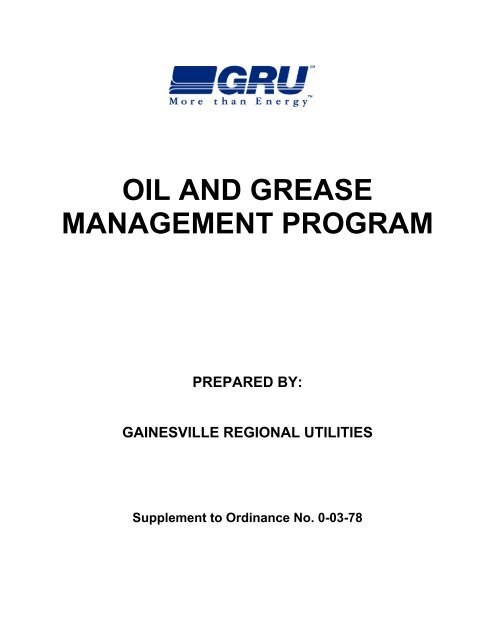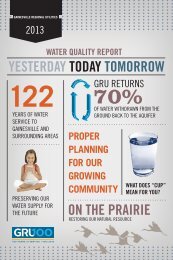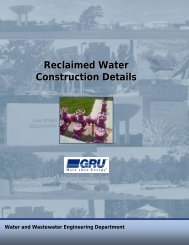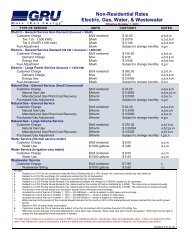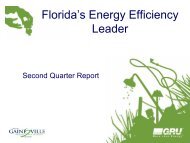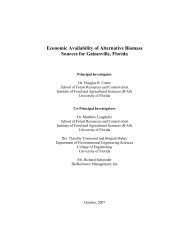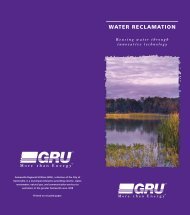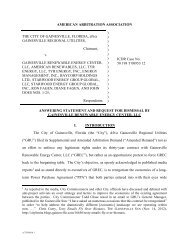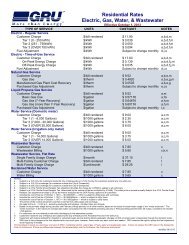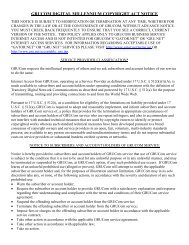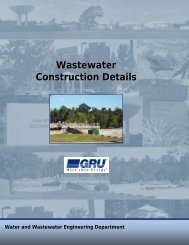Oil and Grease Manual - Gainesville Regional Utilities
Oil and Grease Manual - Gainesville Regional Utilities
Oil and Grease Manual - Gainesville Regional Utilities
Create successful ePaper yourself
Turn your PDF publications into a flip-book with our unique Google optimized e-Paper software.
OIL AND GREASEMANAGEMENT PROGRAMPREPARED BY:GAINESVILLE REGIONAL UTILITIESSupplement to Ordinance No. 0-03-78
<strong>Gainesville</strong> <strong>Regional</strong> <strong>Utilities</strong> <strong>Oil</strong> <strong>and</strong> <strong>Grease</strong> Management Program page 2
TABLE OF CONTENTSSection Title Page1.0 Introduction 32.0 Definitions 33.0 General Requirements 54.0 Design 55.0 Capacity 56.0 Installation 67.0 Maintenance 68.0 <strong>Grease</strong> Cleaning Performance Requirements 79.0 Determination of Compliance with Maintenance Requirements 810.0 Variance Procedure for <strong>Grease</strong> Interceptor Maintenance 911.0 Administrative Procedures 912.0 Enforcement 913.0 Correspondence 10Appendix A -- <strong>Grease</strong> Trap Permit Form 13Appendix B – <strong>Grease</strong> Interceptor, <strong>Grease</strong> Trap, <strong>and</strong><strong>Oil</strong>/Water Sizing Criteria15Appendix C – <strong>Grease</strong> Trap Construction St<strong>and</strong>ards – DoubleCompartment17Appendix D – <strong>Grease</strong> Trap Evaluation Form 19Appendix E – <strong>Grease</strong> Trap / Interceptor Maintenance Forms 21Appendix F – Application for Variance of MaintenanceFrequency23<strong>Gainesville</strong> <strong>Regional</strong> <strong>Utilities</strong> <strong>Oil</strong> <strong>and</strong> <strong>Grease</strong> Management Program page 3
1.0 INTRODUCTIONWastewater discharges containing high concentrations of oil <strong>and</strong> grease from food service facilitiesare the main cause of blockages <strong>and</strong> overflows in the City's wastewater collection system.Overflows of wastewater into the stormwater collection system <strong>and</strong> natural bodies of water couldbe greatly reduced by controlling the discharge of oil <strong>and</strong> grease into the wastewater collectionsystem. This source of pollution is also readily preventable by good management practices <strong>and</strong>proper maintenance at food service facilities. To address this issue, the City has developed an oil<strong>and</strong> grease management program.The objectives of the oil <strong>and</strong> grease management program are to:• Eliminate sewer system overflows.• Reduce the amount of oil <strong>and</strong> grease discharged to the wastewater collection system.• Reduce maintenance costs for the wastewater collection system.• Improve operation of the wastewater collection system.• Recover equitable costs for excessive loading of high strength wastewater (e.g. wastewaterhigh in COD)2.0 DEFINITIONSApproved - Describing a method or design acceptable to GRU.City - The City of <strong>Gainesville</strong>, doing business as <strong>Gainesville</strong> <strong>Regional</strong> <strong>Utilities</strong> (GRU).Customer - The person responsible for payment of water service used at a specific location, <strong>and</strong>further defined as that person who signed the application requesting that services be madeavailable at the specific location <strong>and</strong> thereby agreeing to pay for all usage of such serviceoccurring at the location.Food Service Facility - Any facility which prepares <strong>and</strong>/or packages food or beverages for sale orconsumption, on or off-site, with the exeption of private residences, including but not limited to foodcourts, food manufacturers, food packagers, restaurants, grocery stores, bakeries, lounges,hospitals, hotels, nursing homes, churches, schools.<strong>Grease</strong> - A liquid or solid material, composed primarily of fats <strong>and</strong> oils from animal or vegetablesources.<strong>Grease</strong> Hauler - A person who collects the contents of a grease interceptor or trap <strong>and</strong> transportsit to an approved recycling or disposal facility.<strong>Grease</strong> Interceptor - A device, ususally located underground <strong>and</strong> outside of a food service facility,designed to collect, contain, <strong>and</strong> remove food wastes <strong>and</strong> grease from the wastestream while<strong>Gainesville</strong> <strong>Regional</strong> <strong>Utilities</strong> <strong>Oil</strong> <strong>and</strong> <strong>Grease</strong> Management Program page 4
allowing the remaining wastewater to be discharged to the wastewater collection system by gravity.<strong>Grease</strong> Trap - A device, usually located inside the building <strong>and</strong> under a sink of a food servicefacility designed to collect, contain, <strong>and</strong> remove food wastes <strong>and</strong> grease from the wastestreamwhile allowing the remaining wastewater to be discharged to the wastewater collection system bygravity.Normal Strength Wastewater - Wastewater with constituents which do not exceed the followinglimits:ConstituentMaximum Concentration (mg/L)Total Solids 700Total Volatile Solids 490Fixed Volatile Solids 210Total Suspended Solids 250Volatile Suspended Solids 175Fixed Suspended Solids 75Total Dissolved Solids 450Volatile Dissolved Solids 315Fixed Dissolved Solids 135BOD (5-day) 250COD 375Total Kjeldahl Nitrogen 65Organic Nitrogen 25Ammonia Nitrogen 40Nitrate/Nitrite Nitrogen 40Chlorides 75Alkalinity 150Fats 30Total Phosphorus 15<strong>Oil</strong>/Water Separator - A device designed to remove oil (e.g. petroleum-based) from thewastestream while allowing the remaining wastewater to be discharged to the wastewatercollection system by gravity.<strong>Gainesville</strong> <strong>Regional</strong> <strong>Utilities</strong> <strong>Oil</strong> <strong>and</strong> <strong>Grease</strong> Management Program page 5
3.0 GENERAL REQUIREMENTSAll nonresidential facilities that prepare, process or serve food as determined by the AssistantGeneral Manager for Water/Wastewater <strong>Utilities</strong> or his/her designee are required to have a greaseinterceptor discharge permit issued by GRU <strong>and</strong> an approved grease interceptor or approvedgrease trap.The grease trap/interceptor discharge permit for any facility shall be renewed whenever there is asignificant change in operation including facility expansion, remodeling that requires a plumbingpermit, or change in ownership.Multifamily dwellings which are found by GRU to be contributing grease in sufficient quantities tocause main line stoppages, maintenance problems at lift stations, or increased maintenance in thecollection system shall be required by the Assistant General Manager for Water/Wastewater<strong>Utilities</strong> or his/her designee to install an approved grease interceptor.Automotive-related facilities including but not limited to car-washes <strong>and</strong> automobile repair shops,which may contribute petroleum-based oil to the collection system, shall be required by theAssistant General Manager for Water/Wastewater <strong>Utilities</strong> or his/her designee to install anapproved oil/water separator.<strong>Grease</strong> interceptors, grease traps, <strong>and</strong> oil/water separators shall be installed solely at thecustomer's expense. Proper operation, maintenance, <strong>and</strong> repair of grease interceptors, greasetraps, <strong>and</strong> oil/water separators shall be done solely at the customer's expense.4.0 DESIGN<strong>Grease</strong> interceptors, grease traps <strong>and</strong> oil/water separators shall be designed <strong>and</strong> constructed inaccordance with the provisions herein, the City Engineering St<strong>and</strong>ards <strong>Manual</strong>, most currentedition, <strong>and</strong> other applicable State <strong>and</strong> local regulations. Design <strong>and</strong> construction shall beapproved by the Assistant General Manager for Water/Wastewater <strong>Utilities</strong> or his/her designee.Appendix C contains approved construction st<strong>and</strong>ards for grease interceptors.Alternative oil <strong>and</strong> grease removal technologies shall be subject to written approval by theAssistant General Manager for Water/Wastewater <strong>Utilities</strong> or his/her designee.<strong>Grease</strong> interceptors shall be equipped with two 24-inch diameter traffic-bearing covers to allow forproper maintenance <strong>and</strong> inspection (see Appendix C).<strong>Grease</strong> interceptors shall be equipped with a sampling port at the outlet of the interceptor.5.0 CAPACITYThe capacity of the approved grease interceptor, grease trap or oil/water separator shall bedetermined by the Assistant General Manager for Water/Wastewater <strong>Utilities</strong> or his/her designee.Capacity shall be determined in accordance with criteria shown in Appendix B. The AssistantGeneral Manager for Water/Wastewater <strong>Utilities</strong> or his/her designee may use other criteriadetermined on a case-by-case basis.<strong>Gainesville</strong> <strong>Regional</strong> <strong>Utilities</strong> <strong>Oil</strong> <strong>and</strong> <strong>Grease</strong> Management Program page 6
The minimum capacity of any grease interceptor shall be 750 gallons. The maximum capacity ofany grease interceptor shall be 1500 gallons. Where sufficient capacity cannot be achieved with asingle interceptor, installation of grease interceptors in series shall be required.6.0 INSTALLATION<strong>Grease</strong> interceptors shall be installed in a location outside of the customer's facility, which provideseasy access at all times for inspection, cleaning, <strong>and</strong> maintenance, including pumping.<strong>Grease</strong> interceptors shall be located in the food service facility lateral sewer line between allfixtures which may introduce grease into the sewer system <strong>and</strong> the connection to the wastewatercollection system. Such fixtures shall include but not be limited to sinks, dishwashers, garbagedisposals, floor drains in food preparation <strong>and</strong> storage areas, <strong>and</strong> any other fixture which isdetermined to be a potential source of grease.Wastewater from sanitary facilities shall not be introduced into the grease interceptor, grease trap,or oil/water separator under any circumstances.<strong>Grease</strong> traps shall be equipped with a device to control the rate of flow through the unit. The rateof flow shall not exceed the manufacturers rated capacity recommended in gallons per minute forthe unit.The flow control device <strong>and</strong> the grease trap shall be vented in accordance with the FloridaPlumbing Code current edition. The vent shall terminate not less than six (6) inches above theflood-rim level or in accordance with the manufacturer's instructions.7.0 MAINTENANCECleaning <strong>and</strong> maintenance of the grease interceptor, grease trap or oil/water separator shall be theresponsibility of the customer.It shall be the responsibility of the customer to inspect the grease interceptor, grease trap oroil/water separator during the pumping or maintenance procedure to ensure that the cleaning isdone properly <strong>and</strong> that all fittings <strong>and</strong> fixtures inside the interceptor, trap, or separator are inworking condition <strong>and</strong> functioning properly.The customer shall be responsible for the cost <strong>and</strong> scheduling of all repairs to its greaseinterceptor, grease trap, or oil/water separator. Repairs required by the Assistant General Managerfor Water/Wastewater <strong>Utilities</strong> or his/her designee shall be completed within 14 days after the datethat the written notice is received by the customer, unless GRU approves a different completiondate in writing.Cleaning shall include the complete removal of all contents, including floating materials,wastewater, <strong>and</strong> bottom sludge <strong>and</strong> solids.<strong>Gainesville</strong> <strong>Regional</strong> <strong>Utilities</strong> <strong>Oil</strong> <strong>and</strong> <strong>Grease</strong> Management Program page 7
<strong>Grease</strong> interceptors shall be pumped out completely in accordance with the minimum frequenciesoutlined in Table 1, or more frequently as needed to prevent carry over of grease into the collectionsystem. If the pump-out frequency is monthly there shall be a minimum period of three weeksbetween each required pumping.<strong>Grease</strong> traps shall be cleaned a minimum frequency of once per week, or more often as necessaryto prevent pass-through of grease into the collection system.<strong>Oil</strong>/water separators shall be cleaned out completely a minimum frequency of once every 6 monthsor more frequently as needed to prevent carry over of petroleum based products into the collectionsystem.Wastes removed from each grease interceptor, grease trap or oil/water separator shall bedisposed at a facility permitted to receive such wastes. In no way shall the wastes be returned toany private or public portion of the collection system or the wastewater treatment plant withoutprior written approval from the Assistant General Manager for Water/Wastewater or his/herdesignee.No additives may be used in a grease interceptor, grease trap or oil/water separator unlessapproved in writing by the Assistant General Manager for Water/Wastewater or his/her designeeprior to introduction into the wastestream, interceptor, or separator. The use of additives shall notbe considered as a substitute for the maintenance requirements set herein.Flushing the grease interceptor or grease trap with water having a temperature in excess of 140'Fis prohibited.All costs associated with proper maintenance of the grease interceptor, grease trap, or oil/waterseparator shall be borne by the customer.The return of gray water back into the grease interceptor from which the wastes were removed isprohibited unless approved in writing by the Assistant General Manager for <strong>Utilities</strong> or his/herdesignee.8.0 <strong>Grease</strong> Cleaning Performance RequirementsGRU requires complete removal of solids <strong>and</strong> liquids from the grease interceptor without returningany liquid to the grease interceptor during routine cleanings. <strong>Grease</strong> haulers <strong>and</strong> disposalcompanies that meet this requirement will be listed in GRU's grease control brochure beingdistributed to new <strong>and</strong> existing customers.GRU reserves the right to allow alternative grease interceptor cleaning methods if the followingconditions are met:• The entire contents of the grease interceptor must be removed prior to returning any liquid backto the grease interceptor. Decanting the top grease layer without removing the bottom solids isstrictly prohibited.<strong>Gainesville</strong> <strong>Regional</strong> <strong>Utilities</strong> <strong>Oil</strong> <strong>and</strong> <strong>Grease</strong> Management Program page 8
• The alternative cleaning method must achieve 80% or greater removal efficiency for solids <strong>and</strong>grease. Proof of removal efficiency shall be as required by GRU <strong>and</strong> shall be conducted in thepresence of GRU personnel.• The determination of removal efficiency shall be as follows:Composite Chemical Oxygen Dem<strong>and</strong> of Liquid Pumped from <strong>Grease</strong> Interceptor = CODoutComposite Chemical Oxygen Dem<strong>and</strong> of Liquid Returned to <strong>Grease</strong> Interceptor = CODbackThe alternative cleaning method is acceptable if, <strong>and</strong> only if:CODout x 0.2 > CODbackThe alternative cleaning method must be approved in writing by the Assistant General Manager forWater/Wastewater or his/her designee. GRU reserves the right to increase the minimum pumpingfrequencies listed in Table 1 or assess excess strength charges according to City of <strong>Gainesville</strong>Code of Ordinances, Appendix A, Schedule of Fees, Rates, <strong>and</strong> Charges, for any customer usingan alternative grease interceptor cleaning method.9.0 DETERMINATION OF COMPLIANCE WITH MAINTENANCE REQUIREMENTSA grease interceptor shall be considered out of compliance if any of the following conditions exist:• The grease layer on top exceeds 6 inches in depth as measured by an approved dippingmethod or• The solids layer on the bottom exceeds 8 inches in depth as measured by an approved dippingmethod or• The total volume of captured grease <strong>and</strong> solid material displaces more than 20% of thecapacity of the interceptor as calculated using an approved dipping method or• The removal efficiency, as determined by sampling <strong>and</strong> analysis of COD or TSS, is less thaneighty percent (80%).The customer shall be responsible for cleaning a grease interceptor that is out of compliance within14 days after the date the customer receives written notice, unless GRU approves a differentcompletion date in writing.GRU reserves the right to assess excess strength charges according to City of <strong>Gainesville</strong> Code ofOrdinances, Appendix A, Schedule of Fees, Rates, <strong>and</strong> Charges to any customer whosewastewater exceeds any of the discharge limits for normal strength wastewater.<strong>Gainesville</strong> <strong>Regional</strong> <strong>Utilities</strong> <strong>Oil</strong> <strong>and</strong> <strong>Grease</strong> Management Program page 9
10.0 VARIANCE PROCEDURE FOR GREASE INTERCEPTOR MAINTENANCE FREQUENCYIf a food service facility determines that the pumping frequency, as determined from Table 1, oftheir grease interceptor is unnecessary in order to remain in compliance with the criteria of section9.0, the facility may make written application to GRU for a variance of the monthly pumpingrequirements by submitting the Variance Application form (see Appendix F) along with the varianceapplication fee of $300. GRU shall determine the variance based on inspection of the greasetrap/interceptor <strong>and</strong> the nature of operations of the food service facility.GRU may determine the maintenance frequency using the following procedure:• A GRU representative shall observe the pump-out procedure <strong>and</strong> inspect the interceptor on aspecified date <strong>and</strong> time.• After the pump-out <strong>and</strong> initial inspection when either the level of grease reaches 6 inches or thelevel of solids reaches 8 inches or the interceptor reaches any point of non-compliance with thecriteria in section 8, the GRU representative shall use the number of days from the initialpumping date to the final re-inspection date to establish the pumping frequency requirement tobe included in the variance granted.11.0 ADMINISTRATIVE PROCEDURESA maintenance log for grease interceptors, grease traps <strong>and</strong> oil/water separators shall bemaintained on-site by the customer including data for at least the previous 12 months. The logshall include the date, time, maintenance performed, the volume removed each pump-out, <strong>and</strong> thename, signature, <strong>and</strong> contact information of the person who performed the maintenance. Thecustomer shall provide the reports upon request during routine inspections by the AssistantGeneral Manager for Water/Wastewater or his/her designee.12.0 ENFORCEMENT<strong>Grease</strong> interceptors, grease traps, <strong>and</strong> oil/water separators shall be inspected by GRU asnecessary to assure compliance with the requirements herein. The Assistant General Manager forWater/Wastewater <strong>Utilities</strong> or his/her designee shall have the right to enter the premises of anynon-residential facility at all reasonable times for the purpose of inspection, observation, recordsexamination, measurement, sampling, <strong>and</strong> testing in accordance with the provisions includedherein.A notice of violation shall be issued to a customer for failure to:• Obtain a grease trap/interceptor discharge permit• Properly maintain the grease interceptor, grease trap or oil/water separator including failure tomake necessary repairs• Maintain records on-site of pump-outs for grease interceptors<strong>Gainesville</strong> <strong>Regional</strong> <strong>Utilities</strong> <strong>Oil</strong> <strong>and</strong> <strong>Grease</strong> Management Program page 10
Upon receiving a notice of violation, the customer shall have 10 days to complete corrective action<strong>and</strong> submit evidence of compliance to the Assistant General Manager for Water/Wastewater<strong>Utilities</strong> or his/her designee.Should a customer fail to properly maintain a grease interceptor, grease trap, or oil/water separatoraccording to the provisions set herein the Assistant General Manager for Water/Wastewater<strong>Utilities</strong> or his/her designee may pursue one or more of the following actions:• Issue a notice of violation to the customer• Notify the Alachua County Health Department• Notify Alachua County or City of <strong>Gainesville</strong> Codes Enforcement• Perform maintenance on the grease interceptor, grease trap, or oil/water separator <strong>and</strong> chargethe customer for the costs to perform the maintenance including administrative costs.• Assess the customer excess strength charges including sampling, laboratory analysis, <strong>and</strong>administrative costs according to City of <strong>Gainesville</strong> Code of Ordinances, Appendix A,Schedule of Fees, Rates, <strong>and</strong> Charges.• Terminate water <strong>and</strong>/or sewer service.13.0 CORRESPONDENCEAddress all correspondence (including completed maintenance forms) to the following address:<strong>Oil</strong> & <strong>Grease</strong> Management Program<strong>Gainesville</strong> <strong>Regional</strong> <strong>Utilities</strong>P.O. Box 147117Interoffice Box A-122<strong>Gainesville</strong>, FL 32614-7117Fax: 352-334-2752Phone: 352-393-1652 or 393-1698<strong>Gainesville</strong> <strong>Regional</strong> <strong>Utilities</strong> <strong>Oil</strong> <strong>and</strong> <strong>Grease</strong> Management Program page 11
<strong>Gainesville</strong> <strong>Regional</strong> <strong>Utilities</strong> <strong>Oil</strong> <strong>and</strong> <strong>Grease</strong> Management Program page 12
APPENDIX AGREASE INTERCEPTORPERMIT APPLICATION<strong>Gainesville</strong> <strong>Regional</strong> <strong>Utilities</strong> <strong>Oil</strong> <strong>and</strong> <strong>Grease</strong> Management Program page 13
APPENDIX BGREASE INTERCEPTOR,GREASE TRAP, ANDOIL/WATER SIZING CRITERIA<strong>Gainesville</strong> <strong>Regional</strong> <strong>Utilities</strong> <strong>Oil</strong> <strong>and</strong> <strong>Grease</strong> Management Program page 15
<strong>Gainesville</strong> <strong>Regional</strong> <strong>Utilities</strong> <strong>Oil</strong> <strong>and</strong> <strong>Grease</strong> Management Program page 16
APPENDIX CGREASE TRAPCONSTRUCTIONSTANDARDS – DOUBLECOMPARTMENT
<strong>Gainesville</strong> <strong>Regional</strong> <strong>Utilities</strong> <strong>Oil</strong> <strong>and</strong> <strong>Grease</strong> Management Program page 18
APPENDIX DGREASE TRAP EVALUATIONFORM<strong>Gainesville</strong> <strong>Regional</strong> <strong>Utilities</strong> <strong>Oil</strong> <strong>and</strong> <strong>Grease</strong> Management Program page 19
<strong>Gainesville</strong> <strong>Regional</strong> <strong>Utilities</strong> <strong>Oil</strong> <strong>and</strong> <strong>Grease</strong> Management Program page 20
APPENDIX EGREASE TRAP /INTERCEPTORMAINTENANCE FORMS<strong>Gainesville</strong> <strong>Regional</strong> <strong>Utilities</strong> <strong>Oil</strong> <strong>and</strong> <strong>Grease</strong> Management Program page 21
<strong>Gainesville</strong> <strong>Regional</strong> <strong>Utilities</strong> <strong>Oil</strong> <strong>and</strong> <strong>Grease</strong> Management Program page 22
APPENDIX FAPPLICATION FORVARIANCE OF MAINTENANCEFREQUENCY<strong>Gainesville</strong> <strong>Regional</strong> <strong>Utilities</strong> <strong>Oil</strong> <strong>and</strong> <strong>Grease</strong> Management Program page 23
<strong>Gainesville</strong> <strong>Regional</strong> <strong>Utilities</strong> <strong>Oil</strong> <strong>and</strong> <strong>Grease</strong> Management Program page 24


